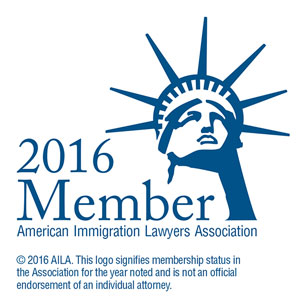I PLEDGE ALLEGIANCE: THE NATURALIZATION OATH AND DUAL CITIZENSHIP
By Gary Endelman and Cyrus D. Mehta
The oath ceremony is often one of the most significant and profound in an immigrant’s journey towards American citizenship. It signifies the end of the immigrant experience and is the final threshold before one’s acceptance as a citizen. It is also a happy moment, and the ceremony is generally accompanied by a stirring speech from a judge or well-known public official. Still, the oath, as prescribed by section 337 of the Immigration and Nationality Act (INA), requires a serious commitment from the immigrant to forever renounce former allegiances, and also insists that the naturalization applicant take the oath without mental reservation or evasion. People may still wish to keep their former citizenship even while becoming American citizens for a number of reasons, such as ease of travel to the country to conduct business or to continue to access the country’s social security and healthcare system. Our blog examines the impact of the oath on the immigrant’s desire to retain his or her citizenship of the former country. At journey’s end, we suggest that, contrary to popular assumption or common understanding, American law is much more tolerant towards and accepting of dual citizenship than most of us, lay and lawyer alike, have ever believed.
The current format of the oath of allegiance is as follows:
“I hereby declare, on oath, that I absolutely and entirely renounce and abjure all allegiance and fidelity to any foreign prince, potentate, state, or sovereignty, of whom or which I have heretofore been a subject or citizen; that I will support and defend the Constitution and laws of the United States of America against all enemies, foreign and domestic; that I will bear true faith and allegiance to the same; that I will bear arms on behalf of the United States when required by the law; that I will perform noncombatant service in the Armed Forces of the United States when required by the law; that I will perform work of national importance under civilian direction when required by the law; and that I take this obligation freely, without any mental reservation or purpose of evasion; so help me God.”
When a UK citizen takes such an oath and becomes an American citizen, what is the effect of this oath on his or her UK citizenship? The oath requires the intending citizen to “absolutely and entirely renounce and abjure all allegiance” to any country that he or she has been a citizen. At the same time, it does not seem that this individual is required to give up UK citizenship. Moreover, since the United States manifestly cannot alter the relationship that any subject or citizen has with the country of their birth or prior citizenship, the import of the naturalization oath lies exclusively as an expression of American attitude and belief. The requirement to renounce all allegiance to your former country does not mean that you have to cease being a citizen of that country. The concept of dual citizenship or dual nationality has long been recognized, and the State Department in recognizing dual nationality states, “A U.S. citizen may acquire foreign citizenship by marriage, or a person naturalized as a U.S. citizen may not lose the citizenship of the country of birth. U.S. law does not mention dual nationality or require a person to choose one citizenship or another.”
UK does not seem to mind when its citizens takes up the citizenship of another country, including American citizenship, which requires the taking of the oath of allegiance. German citizens, in order to retain their citizenship while obtaining the citizenship of another country, must file a Beibenhaltungsgenehmigung prior to applying for American citizenship. Some attorneys have reported isolated instances of naturalization examiners denying the N-400 application on ground that such a person will not be able to take the US oath of allegiance without reservation. Moreover, the Beibenhaltungsgenehmigung asks for the applicant’s personal information such as name, address, date of birth, and the length of residence outside Germany. The form also asks about the applicant’s ties to Germany and detailed reasons why the applicant has to become a citizen of US or another country. No declaration of primary or exclusive allegiance to Germany is required nor does the German procedure demand or expect any act in derogation of US citizenship.
INA section 349 specifies several conditions under which a US citizenship may be lost. These include:
- becoming a naturalized citizen of another country, or declaring allegiance to another country, after reaching age 18;
- serving as an officer in a foreign country’s military service, or serving in the armed forces of a country which is engaged in hostilities against the US;
- working for a foreign government (e.g., in political office or as a civil servant);
- formally renouncing one’s US citizenship before duly authorized US officials; or
- committing treason against, or attempting or conspiring to overthrow the government of the US. .
At no time is the newly minted naturalized American required to give up his or her foreign passport nor is the subsequent use of such passport a potentially expatriating act under INA 349. If Congress had wanted to make post-naturalization travel on a foreign passport a potentially expatriating act, it knew full well how to do so. Under the well-known doctrine of expressio unius est exclusio alterius (“ the express mention of one thing is the exclusion of all others”), such a conspicuous omission is a clear indication that the naturalized citizen does not endanger his or her American citizenship by future travel on a foreign passport, so long as she leaves and enters the United States on an American passport as required by INA 215(b).
The primary effect of recent developments in the US regarding dual citizenship has been to add the requirement that loss of citizenship can only result when the person in question intended to give up his citizenship. At one time, the mere performance of the above (or certain other) acts was enough to cause loss of US citizenship. In Kawasita v United States, 343 US 717, 753(1952) the Supreme Court held that dual citizenship is “ a status long recognized in the law…the concept of dual citizenship recognizes that a person may have and exercise rights of nationality in two countries and be subject to the responsibilities of both. The mere fact that he asserts the rights of one citizenship does not, without more, mean that he renounces the other… when one has a dual citizenship, it is not necessarily inconsistent with his citizenship in one nation to use a passport proclaiming his citizenship in the other…” The trend in US law in recent decades has clearly and consistently been in favor or accepting dual citizenship. Former INA 352(a)(1) deprived a naturalized citizen of citizenship for residence in country of birth within 3 years of naturalization, which was found unconstitutional by the Supreme Court in Schneider v. Rusk, 401 US 815 (1971) and repealed in 1978. US citizens used to lose their citizenship for voting in foreign elections before the Supreme Court ruled otherwise in Afroyim v. Rusk, 377 US 163(1967) . In 1980, the Supreme Court in Vance v. Terrazas, 444 U.S. 252 (1980) reaffirmed that US citizenship could not be taken away from a citizen absent the voluntary performance of an expatriating act done with the intent to give it up. Even the State Department since 1990 has adopted an administrative premise that a “routine” oath of allegiance to a foreign country that does not explicitly require the renunciation of US citizenship will be presumed to have been performed with the intent to retain such citizenship.
Afroyim and Terrazas, by making it more difficult to lose US citizenship, also served to cause the State Department to become more accepting of dual allegiance. Danny Terrazas had obtained a Certificate of Mexican Nationality. Even though he lost his US citizenship, the effect of his case was to make the USA more accepting of dual citizenship by making US citizenship more secure in a constitutional sense. This is further discussed at 7 FAM 1254(e):
“In light of Terrazas, the Department now presumes that U.S. citizens who naturalize as citizens of a foreign state or who declare their allegiance to a foreign state intend, absent evidence to the contrary, to retain their U.S. citizenship (22 C.F.R 50.40(a) and 7 FAM 1222). A U.S. citizen may readily rebut this presumption by either signing the “Statement of Voluntary Relinquishment of U.S. Citizenship” contained in DS-4079 (“Request for Determination of Possible Loss of United States Citizenship”) or by executing a written statement under oath indicating that he or she naturalized as a citizen of a foreign state or declared his or her allegiance to a foreign state voluntarily with the intention of relinquishing U.S. citizenship.” 7 FAM 1254(e)
Readers may also want to consult 7 FAM 1222(a) which contains the post-1990 State Department presumption that naturalization in a foreign state, without more, is presumed by our State Department to have been done with an intent to retain USC status and will not therefore cause loss of US citizenship.
During the late 19th and early 20th centuries, the US ratified a series of expatriation treaties (the “Bancroft treaties”, named after American diplomat George Bancroft). The intent of these treaties was to prevent dual citizenship by providing for automatic loss of citizenship by foreigners who obtained US citizenship, or by Americans who obtained foreign citizenship. As a result of the various Supreme Court decisions on dual citizenship, however, the Bancroft treaties became legally unenforceable, and all of them have by now been formally abrogated by the US. One of these treaties (the one with Sweden) is mentioned in the Supreme Court’s decision in Perkins v. Elg, 307 U.S. 325 (1939). The Bancroft treaties marked a rejection by the US of the common law doctrine of permanent allegiance that dates back to an old English case from 1608 called Calvin’s case. Precisely because of its unique historical origins, born out of revolution and a rejection of the British monarchy, the US developed the notion of expatriation, that one can give up citizenship and acquire new allegiances.
The acceptance of dual citizenship represents a uniquely American return to the concept of permanent allegiance but in a new way. Under the Bancroft 19th century approach, the US embraced the right of its citizens to give up their old allegiances and become Americans. Indeed, the same Congress that defined citizenship in the 1866 Civil Rights Bill and the 14th Amendment, made the right of expatriation part of the corpus of US immigration law. Act of July 27, 2868, c h.249, Sect. 1, 15 Stat. 223 (now codified as INA 349(a)(6) and (7)) (“the right of expatriation is a natural and inherent right of all people, indispensable to the enjoyment of the rights of life, liberty and the pursuit of happiness.”) Now, in the 21st century, while expatriation remains a fundamental constitutional right, we are moving towards what may be called the “globalization of citizenship,” a more elastic but no less durable concept. Originally, common law denied the individual right to stop being a subject of the Crown. Now, the US embraces the right of naturalized citizens to retain their old allegiances while adding new ties to the USA. In effect, citizenship is shorn of its prior exclusivity and endowed with an expansiveness that it previously lacked so that a naturalized or birth right citizen can enjoy the privileges and protections of full membership in the American polity while still being able to retain traditional identities or benefit from the addition of new ones.
The final question is why do we need citizenship as a basis for defining the people of a country? There may come a time when a distinction between a citizen and a non-citizen may be as abhorrent as distinguishing people by the color of their skin. But until then, in a famous article by Alexander Bickel, Citizenship in the American Constitution, 15 Arizona Law Review 369 (1973), Professor Bickel makes a point very much in alignment with our question, namely that one of the key reasons for the stability of the American political system, one of the “secret sauces” as we would like to say, that has contributed to the acceptance and efficacy of our constitutional framework is the fact that traditionally citizenship does not play a supreme role nor endow its holders with rights and privileges far in excess of others. “It is gratifying,” he observes “that we live under a Constitution to which the concept of citizenship means very little.” Bickel at 367. “Had citizenship been that important to the Founding Fathers, surely they would have bothered to define it. Ironically, the surpassing relevance of citizenship lies not in the privileges it preserves or in the distinctions it enshrines but in what Bickel terms its “minimalist role.”” It is precisely such modesty that serves to broaden opportunity for all, to give non-citizens what Jefferson called a “stake in society” so that even those who are not citizens identify the nation’s success and well being with their own.
Immigration law does not evolve in a vacuum but mirrors the society writ large. So, for example, the 1952 Act was chock full of ideological grounds of exclusion in the depths of the Cold War. The 1965 abolition of the national origins quota as an international civil rights bill passed the year after the 1964 civil rights act and the same year as the voting rights act. The American Competitiveness in the 21st Century Act was passed at the height of Clinton prosperity So, with the growing acceptance of dual citizenship the fact that more Americans work abroad than ever before, that American business has gone global, that jet travel has long since become common and is no longer the province of the rich or powerful, that growing numbers of Americans go to college and beyond, that the world is increasingly flat with transfer of technology crossing national boundaries- all of this has made the world smaller, more of a global village. As this has happened, as our horizons have widened, the notion of dual allegiance has become more commonplace and more acceptable to Americans own sense of what kind of a people they are and what manner of nation we have become.
(Guest author Gary Endelman is the Senior Counsel of FosterQuan)




